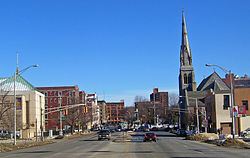Downtown Waterbury Historic District
|
Downtown Waterbury Historic District
|
|

View down West Main Street to Waterbury Green from Meadow Street, 2009
|
|
|
Location within Connecticut
|
|
| Location | Waterbury, CT |
|---|---|
| Coordinates | 41°33′24″N 73°2′33″W / 41.55667°N 73.04250°WCoordinates: 41°33′24″N 73°2′33″W / 41.55667°N 73.04250°W |
| Area | 75 acres (30 ha) |
| Built | Late 19th–Early 20th centuries |
| Architect | Various |
| Architectural style | Various contemporary styles |
| NRHP Reference # | 83001280 |
| Added to NRHP | 1983 |
The Downtown Waterbury Historic District is the core of the city of Waterbury, Connecticut, United States. It is a roughly rectangular area centered on West Main Street and Waterbury Green, the remnant of the original town commons, which has been called "one of the most attractive downtown parks in New England."
The Green was the city's first center, with the buildings around it representing all types of uses, from residences to churches to public buildings. Many early buildings were cleared as the city grew and industrialized. Nearby Exchange Place, the junction of the city's streetcar lines, later emerged as a center for retailing. A devastating 1902 fire in that area led to more clearing and rebuilding. In its wake the city's government buildings were moved to a new municipal complex on Grand Street designed by Cass Gilbert, in accordance with the principles of the City Beautiful movement.
Most of its buildings, large commercial blocks, date to the peak years of the city's industrial prosperity, the late 19th and early 20th centuries. A few earlier buildings survived a devastating 1902 fire. Among them works by locally and nationally prominent architects, the latter group including Henry Bacon and Henry Dudley in addition to Gilbert. They include a variety of contemporary architectural styles, particularly the Second Renaissance Revival, Georgian Revival and Romanesque Revival modes.
In 1983 the area was recognized as a historic district and listed on the National Register of Historic Places. At that time, there were three listings on the Register within the district, including the municipal complex and a pair of houses listed together. Another old hotel has since been listed as well as a contributing property.
...
Wikipedia

